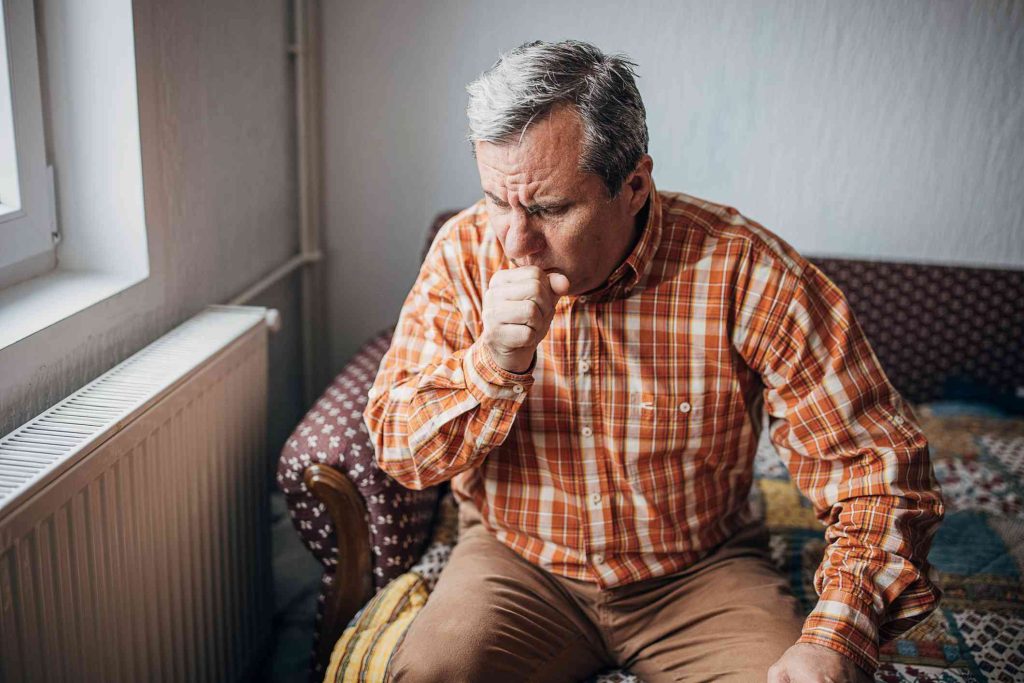:max_bytes(150000):strip_icc():format(jpeg)/Health-GettyImages-1307797821-32718d9705f44829b0bc37e971a5d1a3.jpg)
Black mold is a fungus that develops in damp spaces, often growing in cardboard, paper, soil, or highly humid areas. It releases toxic chemicals through spores or dust.
Common symptoms of black mold include wheezing, sore throat, and stuffy nose. Symptoms can become severe in people with asthma, mold allergies, weaker immune systems, and chronic lung problems.
Some studies have linked mold exposure with pain, difficulty balancing, problems thinking or understanding, anxiety, and depression. However, there’s little evidence that black mold plays a role in these conditions.
Black mold inhalation triggers an allergic reaction. Symptoms center on the lungs and airways, though there can be more widespread effects. Symptoms arise when the immune system releases an antibody, immunoglobin E (IgE), to fight the infection.
While symptoms are more severe in people with allergies, weakened immunity, or asthma, common signs of black mold exposure include:
- Cough that doesn’t go away
- Bouts of sneezing
- Wheezing, gasping for breath
- Chest tightness
- Sore throat, pain with swallowing
- Stuffy nose, congestion
- Postnasal drip
- Red, itchy, and watery eyes, uncontrollable tears
- Skin rash
Asthma Attacks
If you have asthma, allergies, or a chronic lung condition, black mold can trigger attacks or worsen symptoms. Living with mold has been linked to asthma development in children.
Asthma attacks are distinct bouts of symptoms caused by swelling in lung and airway tissues. An attack can last for a few minutes up to several days. Sharing many symptoms with black mold exposure, signs of asthma attacks include:
- Cough
- Chest tightness
- Shortness of breath
- Wheezing
- Difficult or labored breathing
Less commonly, black mold can trigger more severe or chronic conditions. Your chances of developing these are higher if you have weakened immunity, allergies, or a chronic lung condition. More severe cases may lead to:
- Bronchitis: Fungi can cause bronchitis, a lung infection that causes inflamed tissues. Common signs include runny nose, low-grade fever, chest congestion, wheezing or whistling, fatigue, malaise, and coughing out thick, green phlegm.
- Upper respiratory infections: Black mold can cause symptoms in the sinuses and throat, raising the risk of upper airway infections. Common signs include cough, runny nose, fever, chills, sore throat, body aches, fatigue, and breathing difficulty.
- Eczema: In children, mold exposure can lead to atopic dermatitis (eczema), a chronic skin condition. Common signs of eczema include scaly, dry, and cracked skin; swelling; itchiness; rashes; small, raised bumps on brown or black skin; oozing and crusting; and darkened skin around the eyes.
Prolonged exposure to large amounts of mold—often due to construction or farming work—can lead to an additional set of more severe symptoms known as hypersensitivity pneumonitis. Although rare, it is most common in people with severely weakened immunity.
Sometimes called “farmer’s lung,” hypersensitivity pneumonitis symptoms can set on quickly or more gradually. Some people experience symptoms several hours after black mold exposure, while others may not notice signs immediately. The symptoms of hypersensitivity pneumonitis include:
- Shortness of breath
- Chronic cough lasting weeks or months
- Rales, abnormal rattling sounds when you breathe
- Flu symptoms, including fever, chills, muscle aches, joint pains, and headache, often shortly after contact with the mold
- Chest pains
- Tiredness
- Chronic bronchitis symptoms, such as sore throat, chest tightness, wheezing, and others
- Unintended weight loss in chronic cases
- Digital clubbing, a rounding and flattening of the tips of fingers or toes, often with a downward slope
Some reports have linked black mold exposure to other symptoms, but the evidence is lacking. These include headaches, memory problems, brain fog in infants, and pulmonary hemorrhage (bleeding in the lungs) in infants.
Because their immune systems are still developing, children are at increased risk for black mold exposure symptoms. About 6.5% of children under age 18 have asthma—a critical risk factor. Symptoms in children sensitive to black mold are similar to those in adults. Look out for the following:
- Sniffling, runny nose
- Sneezing fits
- Wheezing or loud, labored breathing
- Frequent nosebleeds
- Red or watery eyes
- Sore throat
- Asthma attacks, sudden problems with breathing
- Skin irritation or redness
Since black mold can cause acute (temporary) or chronic problems—especially with repeated exposure—it’s important to know when to get help. Signs you should call your or your child’s primary care provider include:
- Symptoms are severe and disrupt your daily living
- Symptoms aren’t going away, despite treatment
- Symptoms arise with suspected black mold, which has a musty, rotten-vegetable-like smell
- Symptoms with conditions that weaken immunity, such as diabetes or chronic disease
Black mold exposure occurs when people breathe in the toxins and spores of certain fungi that develop in damp spaces. In some people, black mold can cause allergy-like symptoms.
Black mold triggers attacks in people with asthma, causing a range of symptoms, including runny nose, wheezing, and red, watery eyes.
Black mold can cause chronic symptoms, especially among people with chronic disease or weakened immunity. If you suspect black mold is affecting your health, call your healthcare provider.








